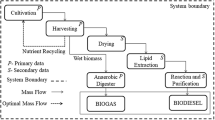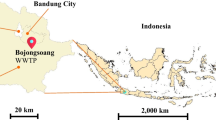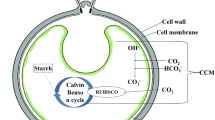Abstract
Among different biofuel feedstocks, algal biodiesel is seen as a promising feedstock. Different research papers have assessed the sustainability of algal biofuel production, but it is always difficult to have a better sense of the results since comparing them with all the differences in data sources, life cycle assumptions, functional units and environmental metrics measured is difficult. The present study develops a comparative life cycle assessment of algal biofuel production under autotrophic and heterotrophic conditions with different inputs. SimaPro 8 was used considering five different scenarios for microalgae cultivation to compare environmental impacts, energy demand and damage analysis associated with water scarcity methodology. Open ponds with three different assumptions of using fresh water, recycled water and waste water, and photobioreactor and heterotrophic technologies are considered. Results were analyzed per energy basis—the functional unit of 1 MJ of energy produced. Results of total GHG emissions show that algae cultivated in pond with wastewater and heterotrophic culture are competitive with tradition fossil fuels. Also the use of algae as the source of energy might increase the energy demand, whereas it does not have adverse impact on the environment, health and climate. The results of the water scarcity indicator show the competiveness of algae oil. This study presents an overview of environmental impacts throughout the full life cycle of a product through different pathways in cultivation stage which demonstrates the importance of decision-making process for further investment.





Similar content being viewed by others
References
Abduli MA, Tavakolli H, Azari A (2013) Alternatives for solid waste management in Isfahan, Iran: a case study. Waste Manag Res 31:532–537
Abu-Ghosh S, Fixler D, Dubinsky Z, Iluz D (2015) Energy-input analysis of the life-cycle of microalgal cultivation systems and best scenario for oil-rich biomass production. Appl Energy 154:1082–1088
Arashiro LT, Montero N, Ferrer I, Acién FG, Gómez C, Garfí M (2018) Life cycle assessment of high rate algal ponds for wastewater treatment and resource recovery. Sci Total Environ 622:1118–1130
Batan L, Quinn J, Willson B, Bradley T (2010) Net energy and greenhouse gas emission evaluation of biodiesel derived from microalgae. Environ Sci Technol 44:7975–7980
Brennan L, Owende P (2010) Biofuels from microalgae—a review of technologies for production, processing, and extractions of biofuels and co-products. Renew Sustain Energy Rev 14:557–577
Canter CE, Blowers P, Handler RM, Shonnard DR (2015) Implications of widespread algal biofuels production on macronutrient fertilizer supplies: nutrient demand and evaluation of potential alternate nutrient sources. Appl Energy 143:71–80
Carvalho AP, Meireles LA, Malcata FX (2006) Microalgal reactors: a review of enclosed system designs and performances. Biotechnol Prog 22:1490–1506
Chen F (1996) High cell density culture of microalgae in heterotrophic growth. Trends Biotechnol 14:421–426
Chen H, Wang J, Zheng Y, Zhan J, He C, Wang Q (2018a) Algal biofuel production coupled bioremediation of biomass power plant wastes based on Chlorella sp. C2 cultivation. Appl Energy 211:296–305
Chen Y, Xu C, Vaidyanathan S (2018b) Microalgae: a robust “green bio-bridge” between energy and environment. Crit Rev Biotechnol 38:351–368
Chiaramonti D, Prussi M, Casini D, Tredici MR, Rodolfi L, Bassi N, Zittelli GC, Bondioli P (2013) Review of energy balance in raceway ponds for microalgae cultivation: re-thinking a traditional system is possible. Appl Energy 102:101–111
Chinnasamy S, Bhatnagar A, Hunt RW, Das K (2010) Microalgae cultivation in a wastewater dominated by carpet mill effluents for biofuel applications. Biores Technol 101:3097–3105
Chisti Y (2007) Biodiesel from microalgae. Biotechnol Adv 25:294–306
Collotta M, Busi L, Champagne P, Romagnoli F, Tomasoni G, Mabee W, Alberti M (2017a) Comparative LCA of three alternative technologies for lipid extraction in biodiesel from microalgae production. Energy Procedia 113:244–250
Collotta M, Champagne P, Mabee W, Tomasoni G, Leite GB, Busi L, Alberti M (2017b) Comparative LCA of flocculation for the harvesting of microalgae for biofuels production. Procedia CIRP 61:756–760
Conkerton E, Wan P, Richard O (1995) Hexane and heptane as extraction solvents for cottonseed: a laboratory-scale study. J Am Oil Chem Soc 72:963–965
Deborah B, Jakob T, Wilhelm C (2017) The effect of climate change on the carbon balance between photosynthesis and respiration in planktonic and benthic microalgae. Book of Abstracts XIIth SCAR Biology Symposium, 10–14 July 2017. University of Groningen, Leuven, Belgium, p 300
Demirbas A (2007) Importance of biodiesel as transportation fuel. Energy Policy 35:4661–4670
Demirbas A, Demirbas MF (2011) Importance of algae oil as a source of biodiesel. Energy Convers Manag 52:163–170
Dones R, Bauer C, Bolliger R, Burger B, Faist Emmenegger M, Frischknecht R, Heck T, Jungbluth N, Röder A, Tuchschmid M (2007) Life cycle inventories of energy systems: results for current systems in Switzerland and other UCTE countries. Final report ecoinvent data v2. 0, p 5
Elduque D, Javierre C, Pina C, Martínez E, Jiménez E (2014) Life cycle assessment of a domestic induction hob: electronic boards. J Clean Prod 76:74–84
Elgowainy A, Han J, Cai H, Wang M, Forman GS, Divita VB (2014) Energy efficiency and greenhouse gas emission intensity of petroleum products at US refineries. Environ Sci Technol 48:7612–7624
Ferreira AF, Ribeiro LA, Batista AP, Marques PA, Nobre BP, Palavra AM, da Silva PP, Gouveia L, Silva C (2013) A biorefinery from Nannochloropsis sp. microalga-energy and CO2 emission and economic analyses. Biores Technol 138:235–244
Fortier M-OP, Roberts GW, Stagg-Williams SM, Sturm BS (2017) Determination of the life cycle climate change impacts of land use and albedo change in algal biofuel production. Algal Res 28:270–281
Fu W, Gudmundsson O, Feist AM, Herjolfsson G, Brynjolfsson S, Palsson BØ (2012) Maximizing biomass productivity and cell density of Chlorella vulgaris by using light-emitting diode-based photobioreactor. J Biotechnol 161:242–249
Gargiulo N, Shibata K, Peluso A, Aprea P, Valente T, Pezzotti G, Shiono T, Caputo D (2018) Reinventing rice husk ash: derived NaX zeolite as a high-performing CO2 adsorbent. Int J Environ Sci Technol 15:1543–1550
Goedkoop M, de Schryver A, Oele M, Durksz S, de Roest D (2008a) Introduction to LCA with SimaPro 7. PRé Consultants, The Netherlands
Goedkoop M, Oele M, de Schryver A, Vieira M, Hegger S (2008b) SimaPro database manual methods library. PRé Consultants, The Netherlands, pp 22–25
Greene CH, Huntley ME, Archibald I, Gerber LN, Sills DL, Granados J, Beal CM, Walsh MJ (2017) Geoengineering, marine microalgae, and climate stabilization in the 21st century. Earth’s Future 5:278–284
Handler RM, Canter CE, Kalnes TN, Lupton FS, Kholiqov O, Shonnard DR, Blowers P (2012) Evaluation of environmental impacts from microalgae cultivation in open-air raceway ponds: analysis of the prior literature and investigation of wide variance in predicted impacts. Algal Res 1:83–92
Handler RM, Shonnard DR, Kalnes TN, Lupton FS (2014) Life cycle assessment of algal biofuels: influence of feedstock cultivation systems and conversion platforms. Algal Res 4:105–115
Hosseinizand H, Lim CJ, Webb E, Sokhansanj S (2017) Economic analysis of drying microalgae Chlorella in a conveyor belt dryer with recycled heat from a power plant. Appl Therm Eng 124:525–532
Institute P. The world’s water [online]. http://www.worldwater.org/data.html. Accessed 18 Oct 2018
ISO I (2006) 14040: Environmental management-life cycle assessment-principles and framework. British Standards Institution, London
ISO/TR (2000) 14049: Environmental management—Life cycle assessment—Examples of application of ISO 14041 to goal and scope definition and inventory analysis, International Organisation for Standardisation
Khoo H, Sharratt P, Das P, Balasubramanian R, Naraharisetti P, Shaik S (2011) Life cycle energy and CO2 analysis of microalgae-to-biodiesel: preliminary results and comparisons. Biores Technol 102:5800–5807
Kumar K, Mishra SK, Shrivastav A, Park MS, Yang J-W (2015) Recent trends in the mass cultivation of algae in raceway ponds. Renew Sustain Energy Rev 51:875–885
Lardon L, Helias A, Sialve B, Steyer J-P, Bernard O (2009) Life-cycle assessment of biodiesel production from microalgae. ACS Publications, Washington, DC
Leesing R, Kookkhunthod S (2011) Heterotrophic growth of Chlorella sp. KKU-S2 for lipid production using molasses as a carbon substrate. In: Proceedings of the international conference on food engineering and biotechnology, pp 87–91
Li Y, Horsman M, Wu N, Lan CQ, Dubois-Calero N (2008) Biofuels from microalgae. Biotechnol Prog 24:815–820
Mata TM, Martins AA, Caetano NS (2010) Microalgae for biodiesel production and other applications: a review. Renew Sustain Energy Rev 14:217–232
Mathew DC (2014) Improving microalgae biofuel production: an engineering management approach. Ph.D dissertation edition. Cranfield university. http://dspace.lib.cranfield.ac.uk/handle/1826/9304
Narala RR, Garg S, Sharma KK, Thomas-Hall SR, Deme M, Li Y, Schenk PM (2016) Comparison of microalgae cultivation in photobioreactor, open raceway pond, and a two-stage hybrid system. Front Energy Res 4:29
Ou X, Yan X, Zhang X, Zhang X (2013) Life-cycle energy use and greenhouse gas emissions analysis for bio-liquid jet fuel from open pond-based micro-algae under China conditions. Energies 6:4897–4923
Parsons S, Chuck C, Mcmanus M (2018) Microbial lipids: Progress in life cycle assessment (LCA) and future outlook of heterotrophic algae and yeast-derived oils. J Clean Produc 172:661–672
Pate R, Klise G, Wu B (2011) Resource demand implications for US algae biofuels production scale-up. Appl Energy 88:3377–3388
Perez-Garcia O, Bashan Y (2015) Microalgal heterotrophic and mixotrophic culturing for bio-refining: From metabolic routes to techno-economics. Springer, Algal biorefineries
Perez-Garcia O, Escalante FM, De-Bashan LE, Bashan Y (2011) Heterotrophic cultures of microalgae: metabolism and potential products. Water Res 45:11–36
Pérez-López P, Montazeri M, Feijoo G, Moreira MT, Eckelman MJ (2018) Integrating uncertainties to the combined environmental and economic assessment of algal biorefineries: a Monte Carlo approach. Sci Total Environ 626:762–775
Pfister S, Koehler A, Hellweg S (2009) Assessing the environmental impacts of freshwater consumption in LCA. Environ Sci Technol 43:4098–4104
Pittman JK, Dean AP, Osundeko O (2011) The potential of sustainable algal biofuel production using wastewater resources. Biores Technol 102:17–25
Posadas E, Alcántara C, García-Encina P, Gouveia L, Guieysse B, Norvill Z, Acién F, Markou G, Congestri R, Koreiviene J (2018) Microalgae cultivation in wastewater. Elsevier, Microalgae-Based Biofuels and Bioproducts
Quinn JC, Davis R (2015) The potentials and challenges of algae based biofuels: a review of the techno-economic, life cycle, and resource assessment modeling. Biores Technol 184:444–452
Quinn JC, Smith TG, Downes CM, Quinn C (2014) Microalgae to biofuels lifecycle assessment—multiple pathway evaluation. Algal Res 4:116–122
Radaelli G, Fleischer D (2014) Systems and methods for extracting lipids from wet algal biomass. Google Patents
Rasoul-Amini S, Montazeri-Najafabady N, Mobasher MA, Hoseini-Alhashemi S, Ghasemi Y (2011) Chlorella sp.: a new strain with highly saturated fatty acids for biodiesel production in bubble-column photobioreactor. Appl Energy 88:3354–3356
Razon LF (2011) Net energy calculations for production of biodiesel and biogas from haematococcus pluvialis and nannochloropsis sp. Zero-carbon Energy Kyoto 2010. Springer, Berlin
Reske J, Siebrecht J, Hazebroek J (1997) Triacylglycerol composition and structure in genetically modified sunflower and soybean oils. J Am Oil Chem Soc 74:989–998
Richmond A (2004) Biological principles of mass cultivation. Biotechnology and applied phycology, Handbook of microalgal culture, pp 125–177
Ridoutt BG, Pfister S (2010) A revised approach to water footprinting to make transparent the impacts of consumption and production on global freshwater scarcity. Glob Environ Change 20:113–120
Rillo E, Gandiglio M, Lanzini A, Bobba S, Santarelli M, Blengini G (2017) Life cycle assessment (LCA) of biogas-fed solid oxide fuel cell (SOFC) plant. Energy 126:585–602
Roostaei J, Zhang Y (2017) Spatially explicit life cycle assessment: opportunities and challenges of wastewater-based algal biofuels in the United States. Algal Res 24:395–402
Savage PE, Hestekin JA (2013) A perspective on algae, the environment, and energy. Environ Prog Sustain Energy 32:877–883
Soh L, Zimmerman J (2011) Biodiesel production: the potential of algal lipids extracted with supercritical carbon dioxide. Green Chem 13:1422–1429
Solomon S, Plattner GK, Knutti R, Friedlingstein P (2009) Irreversible climate change due to carbon dioxide emissions. Proc Natl Acad Sci USA 106:1704–1709
Tavakolli H, Azari A, Ashrafi K, Pour MS (2013) Cementitious properties of steelmaking slags. Tech J Eng Appl Sci TJEAS J 3:1071–1073
Tonon T, Harvey D, Larson TR, Graham IA (2002) Long chain polyunsaturated fatty acid production and partitioning to triacylglycerols in four microalgae. Phytochemistry 61:15–24
Ullah K, Ahmad M, Sharma VK, Lu P, Harvey A, Zafar M, Sultana S (2015) Assessing the potential of algal biomass opportunities for bioenergy industry: a review. Fuel 143:414–423
Walsh MJ, van Doren LG, Shete N, Prakash A, Salim U (2018) Financial tradeoffs of energy and food uses of algal biomass under stochastic conditions. Appl Energy 210:591–603
Wibul P, Malakul P, Pavasant P, Kangvansaichool K, Papong S (2012) Life cycle assessment of biodiesel production from microalgae in Thailand: energy efficiency and global warming impact reduction. Chem Eng Trans 29:1183–1188
Winjobi O, Tavakoli H, Klemetsrud B, Handler R, Marker T, Roberts M, Shonnard D (2018) Carbon footprint analysis of gasoline and diesel from forest residues and algae using integrated hydropyrolysis and hydroconversion plus fischer-tropsch (IH2® plus cool GTL™). ACS Sustain Chem Eng 6:10766–10777
Xiao R, Zheng Y (2016) Overview of microalgal extracellular polymeric substances (EPS) and their applications. Biotechnol Adv 34:1225–1244
Yang J, Xu M, Zhang X, Hu Q, Sommerfeld M, Chen Y (2011) Life-cycle analysis on biodiesel production from microalgae: water footprint and nutrients balance. Biores Technol 102:159–165
Yang F, Hanna MA, Sun R (2012) Value-added uses for crude glycerol—a byproduct of biodiesel production. Biotechnol Biofuels 5:13
Zhang W-N, Liu D-C (2005) A new process for preparation of soybean protein concentrate with hexane-aqueous ethanol mixed solvents. J AOAC Int 88:1217–1222
Acknowledgements
This paper presents research results supported by a Graduate Faculty of Environment, University of Tehran Education Grant (No. 28784/G/14). Any opinions, findings and conclusions or recommendations expressed in this material are those of the authors and do not necessarily reflect the views of the Graduate Faculty of Environment.
Author information
Authors and Affiliations
Corresponding author
Ethics declarations
Conflict of interest
The authors declare that there is no conflict of interest.
Additional information
Editorial responsibility: Shahid Hussain.
Electronic supplementary material
Below is the link to the electronic supplementary material.
Rights and permissions
About this article
Cite this article
Azari, A., Noorpoor, A.R. & Bozorg-Haddad, O. Carbon footprint analyses of microalgae cultivation systems under autotrophic and heterotrophic conditions. Int. J. Environ. Sci. Technol. 16, 6671–6684 (2019). https://doi.org/10.1007/s13762-018-2072-5
Received:
Revised:
Accepted:
Published:
Issue Date:
DOI: https://doi.org/10.1007/s13762-018-2072-5




